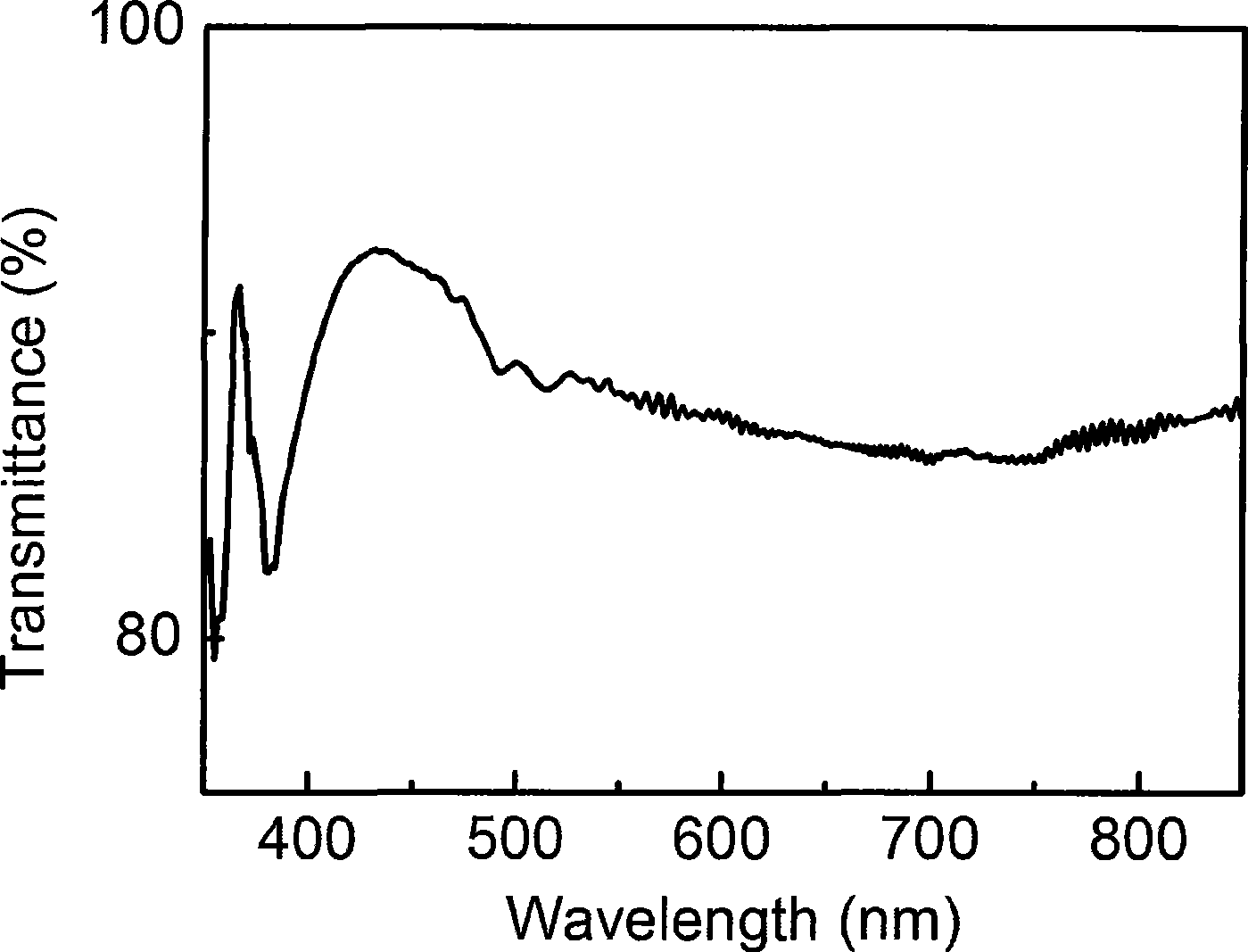Substrate for flexible organic optoelectronic device and preparation method thereof
A technology for optoelectronic devices and substrates, which is applied in the fields of electrical solid-state devices, semiconductor/solid-state device manufacturing, photovoltaic power generation, etc., and can solve problems such as poor adhesion between thin films and substrates
- Summary
- Abstract
- Description
- Claims
- Application Information
AI Technical Summary
Problems solved by technology
Method used
Image
Examples
Embodiment 1
[0157] Such as figure 1 As shown in the substrate structure, the flexible substrate 1 adopts a flexible polyethylene terephthalate polymer (PET) substrate, and the adhesive layer 2 adopts a single-layer free radical UV curing agent-isocyanate thermal curing agent dual curing system, which is electrically conductive. Film 3 is a DC magnetron sputtered ITO transparent conductive film. The transmittance test curve is as figure 2 shown.
[0158] The preparation method is as follows:
[0159] ①Use detergent, acetone solution, ethanol solution and deionized water to ultrasonically clean the PET substrate, and dry it with dry nitrogen after cleaning;
[0160] ② Stir the adhesive diluted 1:10 with ethanol for 20 hours, then spin-coat on the PET surface at a speed of 2000 rpm for one minute, and the film thickness is about 100 nanometers;
[0161] Wherein the ratio of adhesive raw material components is:
[0162] Acrylic resin (free radical UV curing agent) 30-40 parts
[0163] ...
Embodiment 2
[0173] Such as figure 1 As shown in the substrate structure, the flexible substrate 1 is a flexible metal foil substrate, the adhesive layer 2 is a dual curing system of a single-layer free radical UV curing agent-epoxy resin thermal curing agent, and the conductive film 3 is DC magnetron sputtering. ITO transparent conductive film.
[0174] The preparation method is as follows:
[0175] ①Use detergent, acetone solution, ethanol solution and deionized water to ultrasonically clean the PET substrate, and dry it with dry nitrogen after cleaning;
[0176] ② Stir the adhesive diluted 1:10 with ethanol for 20 hours, then spin-coat on the surface of the flexible metal foil substrate at a speed of 2000 rpm for one minute, and the film thickness is about 100 nanometers;
[0177] Wherein the ratio of adhesive raw material components is:
[0178] Unsaturated polyester resin (free radical UV curing agent) 30-40 parts
[0179] Epoxy resin (heat curing agent) 35~45 parts
[0180] Mult...
Embodiment 3
[0189] Such as figure 1 As shown in the substrate structure, the flexible substrate 1 adopts a flexible PET substrate, the adhesive layer 2 adopts a single-layer epoxy cationic UV curing agent-amino resin thermal curing agent dual curing system, and the conductive film 3 is a polymer PEDOT:PSS conductive film.
[0190] The preparation method is as follows:
[0191] ①Use detergent, acetone solution, ethanol solution and deionized water to ultrasonically clean the PET substrate, and dry it with dry nitrogen after cleaning;
[0192] ② Stir the adhesive diluted 1:10 with ethanol for 20 hours, then spin-coat on the PET surface at a speed of 2000 rpm for one minute, and the film thickness is about 100 nanometers;
[0193] Wherein the ratio of adhesive raw material components is:
[0194] Epoxy resin (cationic UV curing agent) 35-45 parts
[0195] Amino resin (thermal curing agent) 40-45 parts
[0196] Thinner (vinyl ether monomer) 4.0~9 parts
[0197] Cationic photoinitiator (...
PUM
 Login to View More
Login to View More Abstract
Description
Claims
Application Information
 Login to View More
Login to View More - R&D
- Intellectual Property
- Life Sciences
- Materials
- Tech Scout
- Unparalleled Data Quality
- Higher Quality Content
- 60% Fewer Hallucinations
Browse by: Latest US Patents, China's latest patents, Technical Efficacy Thesaurus, Application Domain, Technology Topic, Popular Technical Reports.
© 2025 PatSnap. All rights reserved.Legal|Privacy policy|Modern Slavery Act Transparency Statement|Sitemap|About US| Contact US: help@patsnap.com



